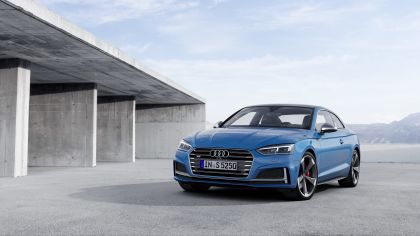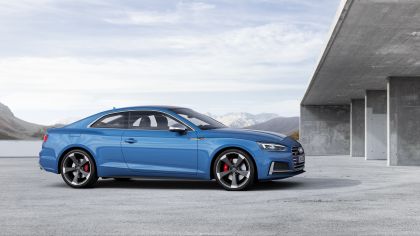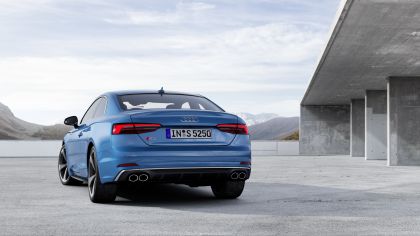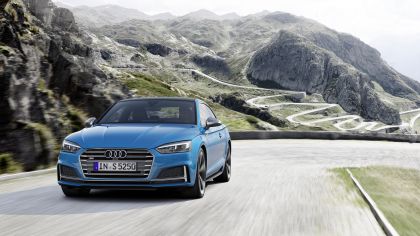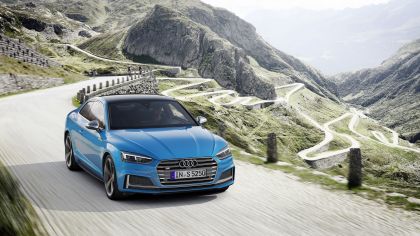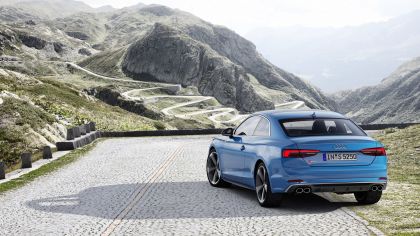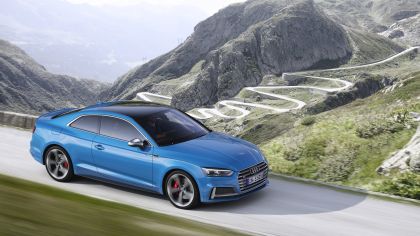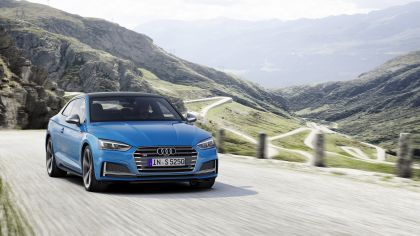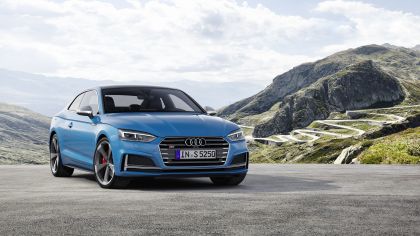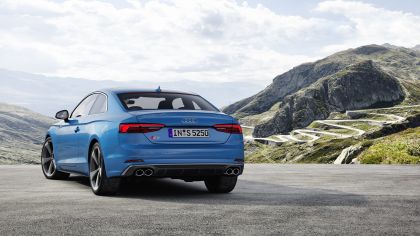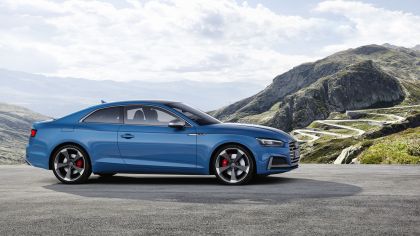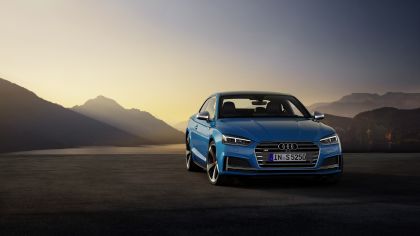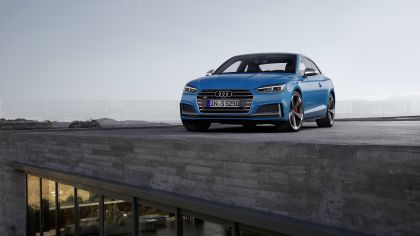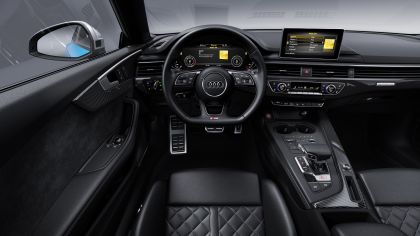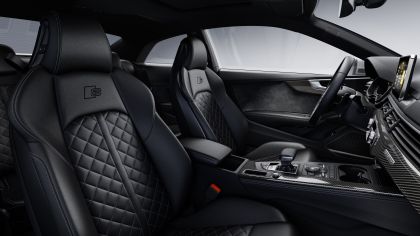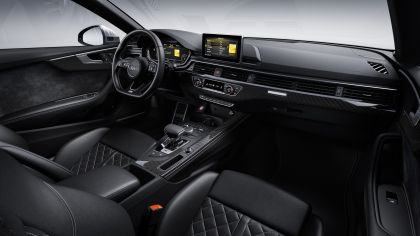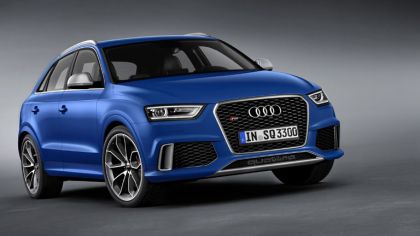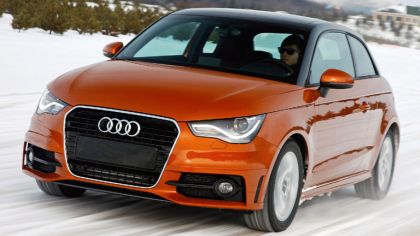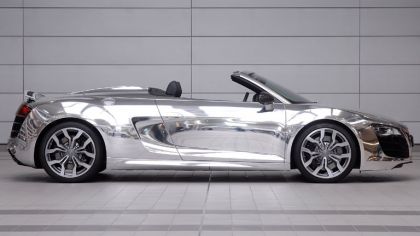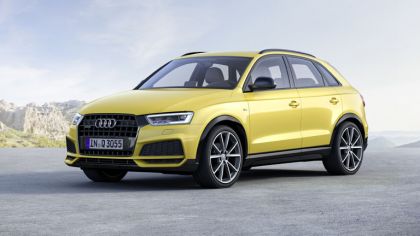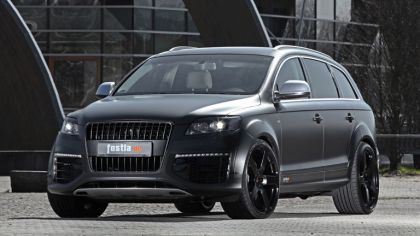For the first time ever, the Audi S5 (Combined fuel consumption for Coupé/Sportback in l/100 km: 6.2 (37.9 US mpg)*; Combined CO2 emissions in g/km: 163 – 161 g/km (262.3 – 259.1 g/mi)*) has a V6 diesel under the hood. The 3.0 TDI engine in the S5 Coupé and the S5 Sportback produces 255 kW (347 hp) and delivers up to 700 Nm (516.3 lb-ft) of torque to the crankshaft. An electric powered compressor provides for strong off-the-line performance; a mild hybrid system enhances efficiency. This combination of power, torque and efficiency makes the S5 unique in its segment.
The 3.0 TDI engine: brawny torque
The 3.0 TDI in the S5 models is the most powerful version in the Audi V6 diesel engine lineup. Its combination of performance and efficiency sets it apart in this segment. Output is 255 kW (347 hp), and 700 Nm (516.3 lb-ft) of torque is available between 2,500 and 3,100 rpm. Despite significantly greater performance, NEDC consumption derived from the WLTP values for the S5 Coupé TDI and the S5 Sportback TDI is just 6.2 liters of diesel per 100 kilometers (37.9 US mpg), a CO2 equivalent of 161 grams per kilometer (259.1 g/mi). The new S models consume on average 19 percent less fuel than their predecessors with gasoline engines despite producing significantly more torque.
The six-cylinder diesel engine accelerates the S5 Coupé in 4.8 seconds and the S5 Sportback in 4.9 seconds from 0 to 100 km/h. The electronically limited top speed is 250 km/h (155.3 mph). With these characteristics, the V6 diesel engine is the ideal power plant for agility, spontaneity, low fuel consumption and long range. It also has a sporty sound and is very smooth.
The engine in the S TDI models features the electric powered compressor (EPC) and mild hybrid technology (MHEV). Both systems are embedded in the standard 48-volt main electrical system. For the first time in the S5 TDI, a powerful 48–volt belt alternator starter is the heart of the mild hybrid system with maximum recuperation power of up to 8 kW. A DC/DC converter steps this voltage down for components in the 12–volt electrical system. A compact, air-cooled lithium-ion battery with a capacity of 0.5 kWh installed under the luggage compartment floor serves as the energy center.
The EPC: fast support for the turbocharger
The electric powered compressor in the Audi S5 TDI is new to this segment. It is located in a bypass downstream of the intercooler and thus close to the engine. From the outside, the compressor looks similar to a conventional turbocharger. A compact electric motor replaces the turbine wheel, however. With an output of up to 7 kW, it accelerates the compressor wheel to 65,000 rpm in approximately 300 milliseconds. It is activated whenever the power demand from the driver is high but the energy available in the exhaust flow for driving the compressor wheel is low. If this is the case, the bypass valve closes and directs the intake air to the EPC. The compressed air flows directly into the combustion chamber. This enables the driver to tap the full power of the 3.0 TDI instantly even at low engine speeds, whether passing another vehicle or accelerating out of a curve. Because the technology increases torque at the lower end of the rpm range, it provides for lower engine speeds and less frequent downshifts during relaxed driving. From a standing start, the new S models quickly move several meters ahead of comparable vehicles without an EPC.
MHEV technology: recuperate or coast
The mild hybrid system in the S models, which is also integrated into the new 48-volt electrical system, has the potential to reduce customer fuel consumption by as much as 0.4 liters per 100 kilometers. Mounted on the end face of the 3.0 TDI is a water-cooled belt alternator starter (BAS), which is connected to the crankshaft via a particularly high-load poly-V belt. The BAS generates a recuperation power of up to 8 kW and 60 Nm (44.3 lb-ft) of torque. It interacts closely with the TDI engine, which in many situations can be operated more closely to its ideal load point as a result. That enhances efficiency.
When drivers take their foot off the accelerator pedal at a speed between 55 and 160 km/h (34.2 to 99.4 mph), the car can coast for up to 40 seconds with the engine shut off completely. The lithium-ion battery continues to supply electricity. The engine management system decides anew in every situation whether coasting, freewheeling or recuperation, i.e. the recovery of kinetic energy, is most efficient. It does this using information from the navigation system and the onboard sensors. The energy recovered by the BAS during coasting and braking flows into the 48-volt storage unit or directly to the electrical consumers.
The mild hybrid system not only reduces fuel consumption; it also provides greater comfort and convenience. The conventional starter is only used to start the car initially, when cold engine oil requires high forces. When the driver presses the accelerator pedal again after a coasting phase or a stop, the BAS restarts the combustion engine. The system does this as required by the driver’s wishes and the situation, from very smoothly to very quickly. Start-stop operation begins at 22 km/h (13.7 mph). When stopped, the engine restarts as soon as the car in front starts to move, even if the brake is depressed.
The engine: torquey and efficient
The 3.0 TDI is a high-tech engine. It produces 255 kW (347 hp), and its maximum torque of 700 Nm (516.3 lb-ft) is available between 2,500 and 3,100 rpm. Its common rail system injects fuel at a pressure of up to 2,500 bar. Crankshaft, pistons, connecting rods and oil management have been designed for high performance, and sophisticated measures have been taken to reduce friction in the crankshaft and camshaft drive. The thermal management system features separate coolant loops for the crankcase and cylinder heads so that the engine oil heats up quickly following a cold start. The coolant flow is directed to the oil cooler, the EPC, the BAS and the compressor case of the turbocharger as needed.
The large turbocharger generates up to 3.4 bar of absolute charging pressure. Its variable turbine geometry (VTG) is optimized for low-loss flow. The external low-pressure exhaust gas recirculation (EGR) system extracts the exhaust gas downstream of the particulate filter. This enables the turbocharger to be operated with the full mass flow, significantly increasing its efficiency.
In many markets outside of Europe, Audi offers the S5 models with a different engine, the 3.0 TFSI. The turbocharged gasoline direct injection engine, which is not equipped with the EPC, has an output of 260 kW (354 hp) and produces 500 Nm (368.8 lb-ft) of torque from 1,370 to 4,500 rpm. These models, too, come with quattro all-wheel drive and the eight-speed tiptronic.
The eight-speed tiptronic: lightning-fast and smooth
The 3.0 TDI transmits its power to a lightning-fast and smooth-shifting eight-speed tiptronic. Its lower gears feature short, sporty ratios, while the upper gears are long to reduce revs and fuel consumption. The driver can let the torque converter automatic transmission work on its own or actively control it, in which case the driver’s commands are transmitted electrically. The shift sequence and connection logic are optimized for the rapid development of traction. The transmission control system avoids unnecessary shifting in stop-and-go situations.
New detailed solutions improve the close interplay between the tiptronic and the mild hybrid system. A clutch in the central transmission interrupts the flow of power when the car is rolling and the engine is either idling or shut off. When coasting, an electric oil pump independent of the combustion engine makes it possible to engage the gear required at restart. Additional technology modules contribute to efficiency. Narrow springs at the multi-plate brakes in the gear sets separate the plates from one another and thus reduce drag torque. The torsion damper in the tiptronic’s converter includes an rpm-adaptive damper that largely attenuates the vibrations of the V6 diesel that occur at very low engine speeds.
quattro permanent all-wheel drive: self-locking center differential
The quattro permanent all-wheel drive system transfers the engine power from the eight-speed tiptronic to the wheels. At the heart of the drivetrain in the Audi S5 Coupé TDI and S5 Sportback TDI is a self-locking center differential. It normally distributes the torque in a ratio of 40:60 between the front and rear axle. If a wheel loses traction, the differential send the majority of the power to the axle with the better grip, with as much as 70 percent going to the front or up to 85 percent to the rear.
During sporty driving, wheel-selective torque control – a software function of the ESC Electronic Stabilization Control – perfects the handling. It brakes the two wheels with reduced load on the inside of a bend slightly before they can begin to spin. The difference between propulsive forces at the wheels makes the car turn into the curve ever so slightly – making handling even more precise, agile and stable.
quattro with sport differential
The optional sport differential further optimizes handling. During dynamic cornering, the sport differential literally pushes the car into the curve and eliminates any hint of understeer. When turning into or accelerating in a curve, most of the torque is distributed to the outside rear wheel. During sporty cornering, the sport differential ensures that steering commands are carried out precisely and stably, providing for outstanding agility. Integration into the Audi drive select dynamic handling system also allows the driver to choose between different sport differential setups.
Sport suspension: optionally with or without fast-acting damper control
The sophisticated suspension contributes to the dynamics of the S models. The front and rear axles are five-link constructions made largely of aluminum. Two subframes connect the links to the body. The track width is 1,587 millimeters (62.5 in) at the front and 1,568 millimeters (61.7 in) at the rear. The Coupé has a wheelbase of 2,765 millimeters (9.1 ft); the Sportback 2,825 millimeters (9.3 ft).
With a ratio of 15.9:1, steering is direct and features an S-specific power assist system. It filters out intrusive road inputs while passing useful information to the steering wheel. Audi also offers dynamic steering as on option. It uses a superposition gear to vary its ratio by up to 100 percent as a function of the car’s speed and the mode selected in the Audi drive select dynamic handling system. At the cornering limit, dynamic steering stabilizes the car with lightning-fast steering inputs.
Audi offers the optional suspension with damper control, in which electromagnetic valves regulate the flow of oil in an energy-efficient manner: Higher power is only provided if the valves are closed to firm up the dampers. There is a wide range between a soft ride and firm handling.
The electronic chassis platform (ECP) controls the dampers in millisecond cycles. The high-tech control unit collects comprehensive information about the movement of the car and the data from the chassis control systems involved. From these, it quickly calculates and precisely coordinates the optimal function of these components. Besides the controlled dampers, the ECP also controls the optional sport differential. The latter and the dynamic steering are integrated into the Audi drive select dynamic handing system, which also affects the throttle valve, tiptronic, power steering and other technology modules. The driver can adjust their function by switching between the profiles comfort, auto, dynamic, efficiency and individual (only with MMI navigation system).
18-inch wheels with 245/40-series tires are standard on the S5 Coupé and the S5 Sportback. 19-inch wheels with 255/35-series tires are optional. Audi sport provides the largest wheels for the two S5 TDI models: 20-inch tires with 265/30-series tires. The brakes are correspondingly large and powerful. The ventilated discs on the front axle measure 375 millimeters (14.8 in) in diameter. They are gripped by black (or optionally red) six-piston fixed calipers with S logos. Electronic Stabilization Control (ESC) is highly precise, and the driver can deactivate it partially or completely.
The design: sporty
Large surfaces, sharp edges, an exciting play of light and shadow – the exterior design of the S5 is embedded in the progressive Audi design language. The continuous shoulder line, which on the S5 Coupé and the S5 Sportback arches dynamically above the wheel housings, is a visual cue to the quattro permanent all-wheel drive.
The wide, low Singleframe grille features three-dimensional aluminum struts and is flanked by the standard LED headlights. The front bumper is strongly three-dimensional and richly contoured. U-shaped clasps structure the large, pentagonal air inlets, which are partly filled with honeycomb grilles. Separate openings on their outer edge direct a portion of the airflow into the wheel housings, where it flows past the wheels for improved aerodynamics. A horizontal, aluminum-look blade in the bumper forms the lower edge of the nose.
When viewed from the side, the exterior mirrors with their aluminum-look housings and the strongly contoured side sills are particularly eye-catching. The S5 Coupé and the S5 Sportback have a spoiler integrated into the luggage compartment lid. LED rear lights with dynamic turn signals are standard. A flat honeycomb grille is integrated into the rear bumper. The diffuser insert in titanium black matt frames the two dual chrome tailpipes of the exhaust system. There is a choice of nine paint finishes, including Quantum Gray, Daytona Gray and Turbo Blue.
The character of cultivated sportiness extends to the interior of the S models. Horizontal lines characterize the design. A wide band of air vents, an elegant air conditioning panel and a large decorative surface define the instrument panel layout. With the rear seatbacks folded down, the Audi S5 Sportback TDI has a luggage capacity of up to 1,300 liters (45.9 cu ft). The S5 models are also available with an optional sensor control for the power luggage compartment lid.
From the headliner to the carpeting, elegant black dominates the interior. The seat coverings – optionally with contrast stitching – are available in either a leather/Alcantara combination or the top leather grade, Fine Nappa. Buyers can choose from the colors black, rotor gray and magma red (only with Fine Nappa). Sport seats with an embossed S logo are standard. Strongly contoured super sport seats with integrated head restraints, rhombus pattern and massage function are optionally available. The MMI display displays a welcome screen with an S5 logo when the ignition is switched on. The illuminated door sill strips, the sport leather steering wheel with multifunction plus and the clasp on the tiptronic selector lever bear the S logo with a red rhombus. The pedal caps and the footrest are stainless steel; the inlays are made of matt brushed aluminum or optionally carbon Atlas.
Controls and infotainment: well-connected and informed
The MMI system on board the S5 models offers a highly modern control logic. With its flat hierarchies, it is oriented on modern smartphones, including the intelligent free-text search function. The voice control function recognizes inputs from everyday speech. The optional Audi virtual cockpit (available in conjunction with MMI navigation plus) presents all key information on its 12.3-inch display. One of the three views from which the driver can choose is the S mode, in which the tachometer takes center stage. The optional head-up display projects important data onto the windshield as symbols and digits.
The infotainment system for the S models is modular, with MMI navigation plus with MMI touch and an 8.3-inch monitor topping the infotainment range. The rotary pushbutton has a touchpad for zooming, scrolling and entering characters. The system includes the Audi connect hardware module, which connects the car to the internet via LTE and also includes a Wi-Fi hotspot. It also delivers the numerous Audi connect internet services to the car, ranging from traffic information online to remote functions. The free myAudi app connects a smartphone with the car.
The optional Audi phone box connects smartphones to the on-board antenna by near-field coupling and charges them inductively using the Qi standard. Particularly discerning hi-fi fans can choose the Bang & Olufsen Sound System with 3D sound. The Audi smartphone interface brings Apple CarPlay and Android Auto on board for iOS and Android phones, respectively.
Driver assistance systems: comfort and safety
The S5 Coupé TDI and S5 Sportback TDI make driving even more relaxed and comfortable with a wide range of driver assistance systems. Some of the solutions are standard features. The optional systems can be ordered either individually or in the “Parking,” “City” and “Tour” packages. Highlights include adaptive cruise control including traffic jam assist, collision avoidance assist, turn assist and rear cross traffic assist.
The Audi S5 models with TDI engines will be available on the European market from May 2019. The starting price in Germany for the S5 Coupé TDI and S5 Sportback TDI is 65,300 euros. This includes popular options from the Audi A5 worth around 7,000 euros as standard equipment. These include LED headlights with dynamic turn signals, S sport suspension with tautly tuned suspension and damping, 18-inch wheels, power-adjustable front sport seats with Alcantara leather, embossed S logo and seat heating, and sportily contoured bumpers.
